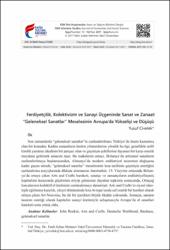| dc.contributor.author | Civelek, Yusuf | |
| dc.date.accessioned | 2018-01-02T11:46:50Z | |
| dc.date.available | 2018-01-02T11:46:50Z | |
| dc.date.issued | 2017-12 | |
| dc.identifier.citation | CİVELEK, Yusuf. "Ferdiyetçilik, Kolektivizm ve Sanayi Üçgeninde Sanat ve Zanaat:“Geleneksel Sanatlar” Meselesinin Avrupa’da Yükselişi ve Düşüşü.", FSM İlmî Araştırmalar İnsan ve Toplum Bilimleri Dergisi, 10 (2017): 61-80. | en_US |
| dc.identifier.uri | http://dergi.fsm.edu.tr/index.php/ia/article/view/822 | |
| dc.identifier.uri | https://hdl.handle.net/11352/2566 | |
| dc.description.abstract | Son zamanlarda “geleneksel sanatlar”ın canlandırılması Türkiye’de önem kazanmış
olan bir konudur. Kadim zanaatların üretim yöntemlerine yönelik bu ilgi, genellikle millî
kimlik yaratma idealinin bir parçası olan ve geçmişin şekillerine dayanan bir karşı-estetik
meydana getirmek amacını taşır. Bu makalenin amacı, Britanya’da artizanal sanatların
canlandırılmaya başlamasından, Almanya’da modern endüstriyel tasarımın doğuşuna
kadar geçen sürede, “geleneksel sanatlar” meselesinin kısa tarihinin geçmişin estetiğini
canlandırma arayışlarında dikkate alınmasını önermektir. 19. Yüzyılın ortasında Britanya’da
ortaya çıkan Arts and Crafts hareketi, sanatçı ve zanaatçıların endüstriyelleşmiş
kapitalizm karşısında güçlerinin eriyip gitmesine duyulan tepkinin sonucunda, Ortaçağ
loncalarının kolektif el üretimini canlandırmayı denemişti. Arts and Crafts’ın siyasî-ideolojik
eğilimine karşılık, yüzyıl dönümünde kıta Avrupa’sında saf estetik bir hareket olarak
ortaya çıkan Art Nouveau, bu tür bir içerikten büyük ölçüde yoksundu. Sonuçta, sanatın
tasarım estetiği olarak kapitalist sanayi üretimiyle uzlaşmasıyla Avrupa’da el sanatları
hareketi sona ermiş oldu. | en_US |
| dc.description.abstract | Nowadays, revitalization of the so-called “traditional arts” is in vogue in Turkey.
The penchant for the artistic crafts of the past aims to generate a counter-aesthetics as
part of the ideal of creating national identity, depending on the shapes of the past. This
paper suggests that from the beginning of the revitalization of artistic crafts in Britain
to the birth of modern industrial design in Germany, the short history of the “traditional
arts” must be taken into account in considerations of reviving the aesthetics of the past.
In the mid-Nineteenth Century, in Britain, the Arts and Crafts movement tried to revive
the collective hand production of the Medieval guilds. Despite the political-ideological
orientation of the Arts and Crafts movement, the continental Art Nouveau that emerged
as pure aesthetics around the turn of the century was usually devoid of such content. As a
consequence of the reconciliation of art as design aesthetics with the capitalist industrial
production, the history of handicrafts came to a halt in Europe. | en_US |
| dc.language.iso | tur | en_US |
| dc.publisher | FSM Vakıf Üniversitesi | en_US |
| dc.rights | info:eu-repo/semantics/openAccess | en_US |
| dc.subject | John Ruskin | en_US |
| dc.subject | Arts and Crafts | en_US |
| dc.subject | Deutsche Werkbund | en_US |
| dc.subject | Bauhaus | en_US |
| dc.subject | Geleneksel sanatlar | en_US |
| dc.subject | John Ruskin | en_US |
| dc.subject | Arts and Crafts | en_US |
| dc.subject | Deutsche Werkbund | en_US |
| dc.subject | Bauhaus | en_US |
| dc.subject | Traditional arts | en_US |
| dc.title | Ferdiyetçilik, Kolektivizm ve Sanayi Üçgeninde Sanat ve Zanaat: “Geleneksel Sanatlar” Meselesinin Avrupa’da Yükselişi ve Düşüşü | en_US |
| dc.title.alternative | The Arts and Crafts in the Triangle of Individualism, Collectivism and Industrialism: The Rise and Fall of the “Traditional Arts” Ideal in Europe | en_US |
| dc.type | article | en_US |
| dc.contributor.department | FSM Vakıf Üniversitesi, FSM İlmî Araştırmalar İnsan ve Toplum Bilimleri Dergisi | en_US |
| dc.relation.publicationcategory | Makale - Ulusal Hakemli Dergi - Kurum Öğretim Elemanı | en_US |



















